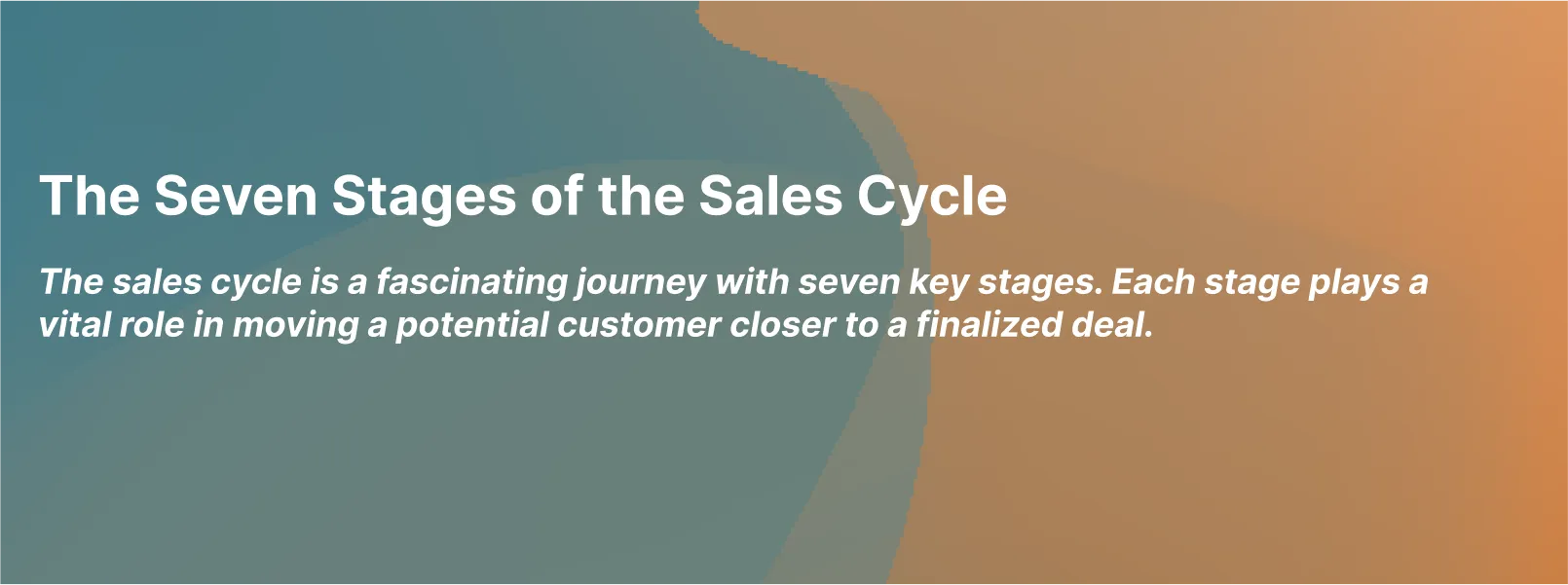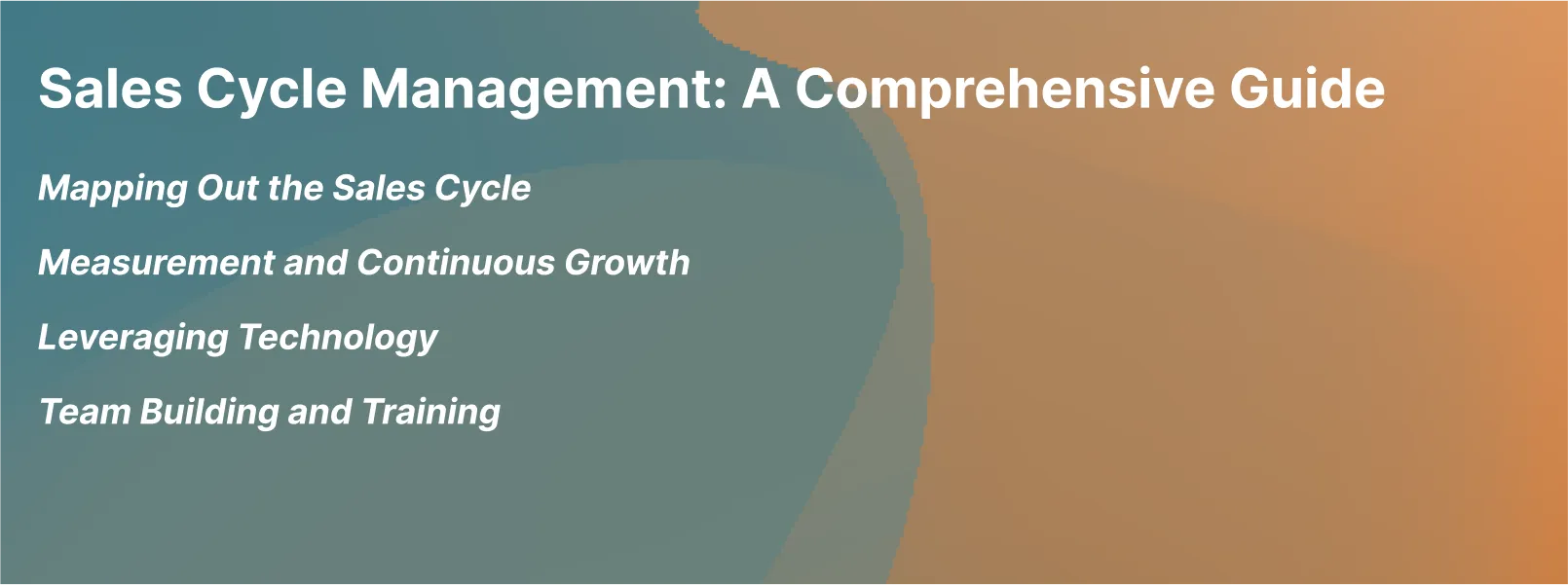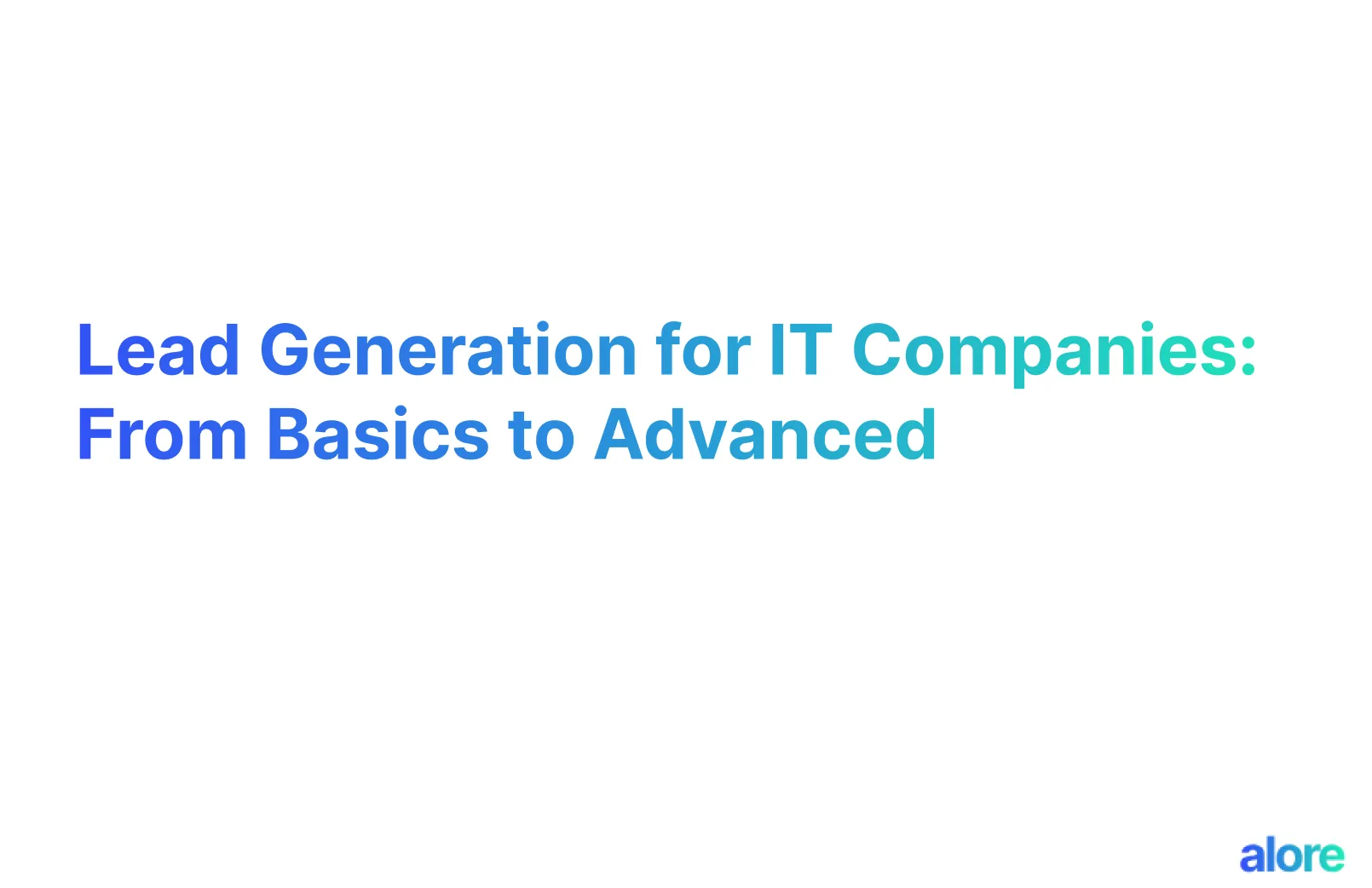
Introduction to Sales Cycle

Understanding the Sales Cycle: What Is Sales Cycle and Why It's Important?
Ever been caught in the alluring dance of retail therapy, only to wonder what's going on behind the scenes?
Well, welcome to the world of the sales cycle, a sequence as orchestrated as a ballet, yet as flexible as a jazz improvisation.
So, what is the sales cycle, and why does it resonate like a drumbeat in the world of sales?
The sales cycle is a series of stages that a sale goes through, starting from the first encounter with a lead to finally closing the deal. It's the roadmap that directs the sales team, keeping them on track, and knowing when to push forward and when to take a step back.
But why is the sales cycle important, you ask?
Imagine running a relay race without knowing where to hand off the baton.
Chaos, right?
A well-defined sales cycle streamlines the process, ensuring no potential customer falls through the cracks.
But here's where it gets even more interesting.
According to data from Harvard Business Review, companies with a structured sales cycle achieve a 15% higher revenue growth compared to those without.
Impressive, right?
A strong sales cycle not only elevates sales but also fosters relationships, nurtures leads, and turns potential customers into loyal brand advocates.
And it's not just about having a sales cycle; it's about understanding it. Realize its importance, and you're halfway to transforming your business's bottom line.
B2B vs. B2C Sales Cycles: A Comparison
Let's talk shop for a moment. In the sales world, there are B2B (business-to-business) and B2C (business-to-consumer), and understanding the distinction between these two is like knowing the difference between jazz and classical music.
They might use the same instruments, but they play entirely different tunes.
Think of B2B sales cycles as a seven-course dinner at a fine dining restaurant. It's complex, takes time, and involves multiple decision-makers.
There are negotiations, long-term relationships, and custom-tailored solutions.
B2C, on the other hand, is more like a fast-food drive-through. Quick, straightforward, and based on emotional triggers rather than logical evaluation.
So, why should you care about the difference? Because it helps you tailor your approach. Just as you wouldn't serve fast food at a fine dining establishment, you wouldn't approach a B2B client with the same strategy as a B2C customer.
In B2B, for example, the industry average of sales cycle is 3 to 6 months, while in B2C, it's usually just a few minutes to a couple of weeks. Recognizing these nuances helps you connect with your audience, offering them precisely what they need.
Tools to Assist the Sales Process: From CRM to Call Centers
Are you tired of juggling countless leads, forgetting follow-ups, and losing potential sales? Enter the modern toolbox of the 21st-century salesperson.
In an era where technology is our trusty sidekick, tools like Customer Relationship Management (CRM) software and call centers have become indispensable. They're not just fancy add-ons; they're essential elements of a streamlined sales cycle.
Think of CRM as your personal assistant, keeping track of leads, follow-ups, and customer interactions. A 2020 study found that businesses using CRM saw a 29% increase in sales. Not too shabby, right?
Call centers or answering services, on the other hand, are your frontline soldiers. They engage potential customers, answer queries, and keep the conversation going.
But wait, there's more! From email marketing software to credit card processing tools, these instruments are not just about making your life easier. They're about enhancing the sales process, ensuring that no lead goes unnoticed, and every potential sale gets the attention it deserves.
Think of these tools as the various instruments in a symphony, each playing its part to create a harmonious melody. A melody that resonates with your customers and turns prospects into profits.
The sales cycle isn't just a term in the business lexicon; it's a dynamic, ever-evolving process that can spell the difference between success and stagnation.
So next time you find yourself caught in the retail dance, remember that behind the scenes is a well-coordinated, meticulously planned strategy that can make or break a business.
Isn't it time you got in step with your sales cycle?
Whether it's B2B or B2C, tools or techniques, understanding the sales cycle is not just the key to sales success; it's the heart of business growth.
The Seven Stages of the Sales Cycle

The sales cycle is a fascinating journey with seven key stages. Each stage plays a vital role in moving a potential customer closer to a finalized deal. Let's explore these sales stages, one by one, understanding what each one entails and how to master them.
Stage 1: Identifying Leads
What It Is
This is where you search for potential customers. Identifying who might need your product or service.
How Do You Go About It
- Research Your Target Audience: Understand who may benefit from your offering.
- Use Various Channels: Utilize social media, websites, and professional networks to find leads.
Stage 2: Connecting with Leads
What It Is
This stage involves initiating contact with the identified leads, whether through a call, email, or in-person meeting.
How Do You Go About It
- Prepare a Personalized Approach: Tailor your connection strategy to each lead.
- Follow Up Regularly: Persistence often leads to success.
Stage 3: Prospecting
What It Is
Prospecting involves qualifying the leads. Not all connections are potential customers, so you need to identify who is genuinely interested.
How Do You Go About It
- Ask Relevant Questions: Determine the needs and interests of the lead.
- Analyze Responses: Gauge the possibility of moving forward with the prospect.
Stage 4: Qualifying Leads
What It Is
Further assessment of the prospect to understand if they are a fit for what you're selling.
How Do You Go About It
- Verify Need and Budget: Ensure that the lead has both the requirement and the financial capacity to buy your product/service.
- Assess Timing: Determine if the lead is ready to make a decision soon.
Stage 5: Presentation
What It Is
The phase where you present your product or service, addressing the product or service to specific needs of the prospect.
How Do You Go About It
- Tailor Your Presentation: Make it about the prospect's specific challenges and how you can solve them.
- Handle Objections Professionally: Be prepared to address concerns or objections.
Stage 6: Handling Objections
What It Is
Addressing any final concerns or objections the lead may have.
How Do You Go About It
- Listen Carefully: Understand the root of the objection.
- Provide Clear Explanations: Offer well-thought-out responses that address concerns.
Stage 7: Closing the Deal and Generating Referrals
What It Is
Finalizing the sale and planting the seeds for future relationships and referrals.
How Do You Go About It
- Clarify Any Remaining Doubts: Ensure the customer is comfortable with the agreement.
- Ask for Referrals: Encourage satisfied customers to refer others.
Understanding and mastering these seven stages of the sales cycle is an art that can lead to successful and rewarding sales experiences.
It's about nurturing relationships, solving problems, and creating a value proposition for your customers. How will you implement these stages in your next sales opportunity?
Sales Cycle Management: A Comprehensive Guide

Ever wondered what the secret sauce behind successful sales is? No, it’s not magic or mere luck; it's called Sales Cycle Management.
So buckle up, because we're diving deep into this essential aspect of demand generation.
Mapping Out the Sales Cycle
What Exactly Is This All About?
You've heard of roadmaps, right? Sales Cycle Management (SCM) is like a GPS for your sales journey. It helps you navigate from the first "hello" to that delightful "cha-ching" when a sale is made.
So How Do You Nail It?
- Analyze the Path: What does your typical customer's journey look like? Understand it like you know your favorite song lyrics.
- Break It Down: Create specific stages for each part of the sales process. Like making the perfect sandwich, each layer matters.
Remember, your roadmap should fit your vehicle, or in this case, your business. One size doesn't fit all.
Measurement and Continuous Growth
What’s the Deal Here?
Measuring success isn't just about numbers; it's like taking the pulse of your sales strategy. Do you want to drive blindfolded? Neither do we!
Here's How to Master It
- Set Clear Goals: What's your destination? Make sure you have a clear and reachable endpoint.
- Track Progress: Use tools that make sense for your business. No, you don't need a scientific calculator; sometimes, a simple spreadsheet will do.
- Adapt and Grow: Sales trends change, just like fashion. Stay updated, or you might end up wearing bell-bottoms in a skinny jeans world.
Leveraging Technology
What's This High-Tech Talk About?
In this tech-savvy era, ignoring technology is like trying to paddle a boat with a spoon. It's exhausting and, frankly, a bit silly.
How to Make Technology Your Friend
- Choose Wisely: Select tools that complement your sales strategy.
- Integrate with Style: Your tech should enhance the sales process, not make it a Frankenstein monster.
Remember, technology is a tool, not a master. Make it work for you.
Team Building and Training
Why Is This So Crucial?
Imagine trying to win a soccer game with a bunch of folks who've never kicked a ball. Terrifying, right? Training and teamwork are the backbone of Sales Cycle Management.
Steps to Score the Winning Goal
- Identify Needs: Where are the gaps? Find them.
- Train with Purpose: Customized training is like a tailored suit; it just fits better.
Never underestimate the power of a well-prepared team. They're your frontline warriors.
Putting It All Together
The Big Picture
SCM isn't a rigid formula; it's a dynamic dance with your customers. Engaging, persuading, adapting – that's what it's all about.
Creating the Perfect Symphony
- Stay Flexible: Rigid doesn't work in dance or sales. Be ready to bend and sway.
- Keep Learning: Just like grandma’s recipes, the best methods often come from experience and continuous learning.
Sales Cycle Management isn't an obscure art form; it's a practical, hands-on approach to steering your sales process. Like the maestro of an orchestra, it's about knowing every instrument, every note, and how to create beautiful music.

Customizing and Improving the Sales Cycle

With the ever-changing dynamics of today's market, improving the sales cycle isn't just an option—it's a necessity. It's time to take a hard look at the methods and strategies you employ within your sales cycle and tailor them to meet the unique demands of your potential customers.
Customizing Your Sales Cycle: From Outlining Details to Reassessing Goals
1. Understanding Your Target Market
Do you know who you're selling to? Identifying your target market is a fundamental first step in the customizing process. When you understand your potential customer's pain points and needs, you can align sales strategies to speak directly to them.
2. Outlining the Sales Cycle Stages
What does your typical sales cycle look like? If you can't define it step by step, you might be leaving opportunities on the table. It's essential to create well-defined sales cycle steps and stages that provide clarity for both your sales team and your prospective clients.
3. Reassessing Goals and Metrics
Key performance indicators (KPIs) guide your sales process, but are they the right ones? Sometimes, reassessing and modifying your goals based on current industry trends can speed up the sales cycle.
How to Speed Up and Improve the Sales Cycle Process: Tips and Techniques
1. Utilizing Technology
Marketing automation, CRM systems, and lead nurturing technologies not only help in tracking leads but also in shortening the sales cycle. Investing in these tools can help in generating quality leads and aligning sales and marketing teams effectively.
2. Streamlining Sales Prospecting
Are your sales reps spending too much time finding potential clients? Leveraging data-driven methods for sales prospecting can help identify sales qualified leads more quickly, allowing more time for close deals.
3. Reducing Sales Cycle Length with Effective Communication
Frequent phone calls and in-person meetings with potential customers can foster trust. Transparency in communication between sales reps and potential clients helps to overcome objections and align expectations.
Sales Team Alignment and Transparent Relationships: Building Success
1. Align Sales and Marketing Teams
Alignment between sales and marketing teams isn't just a buzzword. It's the key to unlocking success. Sharing insights, goals, and strategies create a cohesive environment that can foster better relationships with customers.
2. Build Trust with Transparency
In sales, trust is everything. Building transparent relationships with your customers begins with open communication from the discovery call to the final sales presentation.
Investing in Marketing Automation and Technology for Lead Nurturing
1. Leveraging Automation for Lead Generation
How are you nurturing your leads? Marketing automation can turn a random potential customer into a loyal paying customer by offering timely and relevant information. It the buyer's journey into a step-by-step process that guides them through the buying process.
2. Utilizing Analytics for Continuous Improvement
Using analytics to monitor the effectiveness of your sales process can provide insights into areas that need enhancement. Whether improving service or altering sales techniques, data can guide your decisions.
Your sales cycle isn't set in stone. By customizing your approach and constantly seeking to improve, you enable your business to adapt to an ever-changing marketplace.
With attention to detail and a commitment to ongoing reassessment, you have the tools not just to survive but thrive. If you're serious about creating the perfect sales process, you must be willing to innovate, adapt, and, most importantly, listen to the unique needs of your market.
Best Practices for Sales Process Success

Best Practices for Building a Winning Sales Process
Are you aware of your current sales process? Whether a newcomer to sales pitch or a seasoned pro, understanding and fine-tuning this procedure is crucial. Why, you ask?
Because a strong sales process enables you to reach your target market, qualify prospects, and turn potential leads into paying customers. It's the guidebook your sales team will follow, and it's vital for success.
Let's dive into some insights:
- Identify Sales Qualified Leads: Knowing your potential customers helps your sales team target those more likely to convert.
- Defined Sales Cycle: A well-defined sales cycle provides a step-by-step process, helping your sales reps navigate complex deals.
- Utilize Sales Process KPIs: Key performance indicators help in tracking team performance and identify areas for improvement.
Now, aren't these insights valuable?
Why Your Team Should Have a Sales Cycle: Making Sales Training Easy and Structuring Your Team
Ever been stuck with a sales rep unsure of the next move? A well-structured sales cycle is the answer!
A sales cycle helps in training new members of your sales and marketing team, ensuring they understand the stages of the sales journey. It also helps in aligning sales and marketing teams, bringing coherence to your overall approach.
Here's an example: Let's say your industry average sales cycle length is 60 days. By tracking and working on shortening your own sales cycle length, you can close deals faster and outpace competitors.
Now, who wouldn't want that?
Benefits of a Well-Defined Sales Cycle: Monitoring Team Performance and More
A well-defined sales cycle is not just about selling. It's about building relationships, understanding the buyer prospective customer's journey, and, most importantly, enhancing customer retention.
Here's what a well-defined sales cycle offers:
- Monitoring Team Performance: You can track sales reps and identify where improvements are needed.
- Understanding Pain Points: It helps in identifying and overcoming objections, thus making the buying process smoother.
- Aligning Sales and Marketing Teams: Collaboration becomes more comfortable with defined stages, enhancing overall effectiveness.
Consider this: A sales cycle helps you to not only engage with prospective customers but also gives you the tools to nurture them into loyal clients. Intrigued?
10 Tips to Enhance Your Sales Cycle Process: From Improving Lead Generation to Documenting Your Sales Process
Ready to boost your sales cycle process? Let's explore some actionable steps:
- Improve Lead Generation: Utilize various methods to identify and attract potential customers.
- Utilize Marketing Automation: Automation assists in nurturing leads and helps in aligning sales with your marketing team.
- Focus on Sales Prospecting: Encourage your sales reps to proactively seek new customers.
- Document Your Sales Process: A well-documented process ensures consistency and helps in training sales reps.
- Understand the Typical Sales Cycle: Align your approach with the industry's norms to meet customer expectations.
- Invest in Technology: Tools like CRM help in managing the sales pipeline and facilitate better team performance.
- Personalize Your Sales Pitch: Customizing your pitch helps in overcoming objections and closing more deals.
- Use Data to Your Advantage: Measure sales process KPIs to identify areas for improvement.
- Enhance Customer Service: Happy customers often become repeat customers.
- Explore Phone Calls and In-Person Meetings: Sometimes, a personal touch makes all the difference.
In conclusion, building a robust sales process is not just about selling. It's about creating a journey that resonates with your potential clients, understanding their needs, and providing solutions that fit. From lead generation to closing deals, a well-defined sales process is a tool that can drive success and help your sales team excel.
Accelerating a Lengthy Sales Cycle - Step-by-step process

Are you tired of lengthy sales cycles that drain resources and put unnecessary strain on your sales team? It's not just you. A prolonged sales cycle is a challenge that many companies face, and it's one that can hinder growth if not handled properly. But fret not! In this section, we will unravel the secrets to accelerating those cumbersome sales cycles. So grab your notes and buckle up; you're about to get enlightened!
Invest in a Marketing Automation Platform or Team to Nurture Leads
- Understanding the Need for Automation: We live in an age where the buying process is evolving rapidly. A typical sales cycle may involve multiple stages, and managing them manually can be exhausting. Here's where a marketing automation platform or a dedicated marketing team comes into play.
- Targeted Lead Generation: Imagine knowing exactly when and how to approach your potential customers, having the ability to identify sales qualified leads without breaking a sweat. Automation tools help with just that. They allow you to segment leads, deliver targeted content, and nurture leads effectively, shaving precious time off the sales cycle length.
- Data-Driven Decisions: Want to overcome objections from potential leads? With the right insights and data, you can anticipate objections and respond effectively. Automation tools can provide key performance indicators, helping your sales reps make informed decisions.
- Case Study – XYZ Company: XYZ Company struggled with a lengthy sales cycle. After investing in marketing automation, they reduced their average length of the sales cycle by 30% and saw a surge in new customers.
Maintain a Close and Transparent Relationship with Your Sales Team
- The Power of Collaboration: Why keep your sales and marketing teams in separate silos? Aligning sales and marketing teams not only streamlines communication but also creates a well-defined sales cycle. It enables the team to work together towards common goals, thus enhancing the sales cycle process.
- Training and Structuring the Sales Team: Your sales reps are the front-liners. Investing in training and providing a structured environment makes sales training easy and enhances team performance. And guess what? A well-trained team can close deals more efficiently.
- Transparency in the Sales Process: How do your sales reps understand the stages of the sales cycle? By maintaining transparency in the sales process, you can avoid confusion and foster a sense of ownership. It helps in efficiently moving a prospective customer through the sales pipeline.
- Feedback and Continuous Improvement: Ever considered what your sales reps think about the sales process? Regular feedback can highlight pain points in the sales cycle management. Identifying and addressing these pain points ensures a more efficient sales process, which in turn results in happier paying customers.
- Real-Life Example – ABC Inc.: ABC Inc. fostered a close relationship between their sales and marketing teams. As a result, they increased the leads generated, reduced miscommunication, and accelerated their sales cycle stages.
Conclusion
Accelerating a lengthy sales cycle doesn't have to be a daunting task. By investing in the right tools, nurturing leads effectively, and maintaining a close relationship with your sales team, you can enhance your sales process.
Remember, it's not about implementing every technique out there. It's about finding what works best for your industry and product or service. So why wait? Start working on your perfect sales process today, and watch your business thrive!
Creating Your Success Path for Increased Sales and Revenue

Create Your Winning Sales Cycle Strategy
Building a winning sales cycle strategy is akin to crafting a roadmap for success. Knowing your sales cycle stages ensures efficiency, and recognizing when to pursue a short sales cycle can lead to more deals. A well-crafted sales cycle properly maps out the journey for acquiring new customers and turns potential leads into paying customers. Integrating technology refines your sales processes, and understanding your product or service enhances your value proposition.
How to Customize a Sales Cycle: Objectives, Visual Flowcharts, and Adjusting Goals
Customizing a sales cycle requires targeted objectives for each sales cycle stage. Utilizing visual flowcharts offers clarity, and adjusting goals according to potential clients ensures alignment with market trends and the unique facets of your product or service. Remember, not every lead is a fit; focus on qualifying leads for more successful outcomes.
What are the Benefits of Establishing a Sales Cycle?
Defining a sales cycle fosters clarity, prediction of most future sales cycles' trends, relationship-building with prospective customers, and efficiency in lead generation. It aids in overcoming objections, facilitates better sales presentations, and helps allocate budget authority wisely.
Conclusion: Sales Cycle - A Continuous Work in Progress

Summary and Future Trends in Sales Cycle Development
The sales cycle is like a dance, constantly evolving, with new steps introduced as markets shift and technologies advance. The sales cycle properly navigated has the potential to lead to more deals, but what are the most critical elements to consider?
First, let's talk about the short sales cycle. In most sales cycles, time is of the essence. But does a faster sales cycle stage necessarily mean better? Not always. It's about finding the perfect balance, understanding your target prospect, and adapting to their needs.
Moreover, the various sales processes that companies implement are changing with emerging trends. From AI-powered tools to personalized customer journey maps, businesses are exploring new avenues to reach potential leads.
Now, you might be thinking, "What's the value proposition in adapting to these trends?" The answer lies in aligning with customer expectations and industry standards. Think of it as updating your wardrobe - staying in fashion but also retaining your unique style.
Resources and References for Further Reading
The ocean of information about the sales cycle might seem overwhelming. But don't fret; here's where you can dive deep without drowning:
- Books on Sales Stages: From the beginning to the closing of deals, understand the intricacies of every stage.
- Webinars on Target Customer Profiles: Tailor your approach, and resonate with your audience.
- Guides on How to Generate Leads: Learn the art of fishing in the business world.
- Reports Representing Companies' Sales Success Stories: Real-world insights from those who've walked the path.
Remember, this is not the end; it's the continuation of a fascinating journey. Happy selling!









